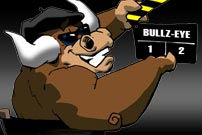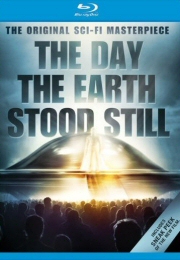 With the temperature dropping, it's time to find someone to keep you warm. Find your hookups with our online dating guide!
With the temperature dropping, it's time to find someone to keep you warm. Find your hookups with our online dating guide!
Frances Bavier, Lock Martin
- Rated G
- Sci-Fi
- 1951
- Buy the DVD
Reviewed by Bob Westal
()
t’s the very early 50s, the Cold War is less than half a decade old, and it’s already gone to the hot place in Korea. Even more frightening, the burgeoning U.S./Soviet nuclear arms race is threatening to take the entire world to a permanent hot place. Meanwhile, increasing numbers of Americans are convinced of a major threat from within the nation, and a popular young senator has recently charged that the U.S. State Department is riddled with Bolshevik infiltrators. In Hollywood, noted entertainers, writers, and craftspeople are losing their careers because of their political beliefs, past and present, real or imagined. And now, a gigantic flying saucer has landed in the middle of the capital mall in Washington, D.C. and there’s a suave spaceman inside it assisted by a very large, very powerful, robot. The alien has been shot by a scared soldier, but he recovers with alarming speed and is soon demanding a meeting with all the leaders of the whole, angry, messed-up world – or else.
Though it’s as full of political and historic subtext as any genre film ever made, you don’t have to understand any of it to appreciate the 1951 original version of “The Day the Earth Stood Still.” The first major Hollywood film to posit a benevolent, if also authoritarian, alien visitor, is best known as the source of eight of the most memorable nonsense syllables to ever emanate from Hollywood: “Gort! Klaatu barada nikto!” But its DNA has infected vast sections of the sci-fi universe, influencing innumerable friendly alien movies, including “Close Encounters of the Third Kind,” “E.T.,” and “The Iron Giant.”
Directed by the supremely versatile Robert Wise (the back-to-back helmer of both 1963’s “The Haunting” and “The Sound of Music”) and written by Edmund H. North (“Patton,” “Sink the Bismarck!”), “The Day the Earth Stood Still” stars British stage actor Michael Rennie as Klaatu, the well-spoken alien on a mysterious mission of peace, who escapes government custody and finds his way to a Georgetown boarding house where he befriends a fatherless boy (Billy Gray) and his young mother (Patricia Neal). Facing stiff resistance from the State Department (Joe McCarthy’s commie infiltrators at work, no doubt) and fearing a very nasty fate for what seems to be a relatively decent planet, he enlists the aid of a great scientist with a suspicious resemblance to Albert Einstein (Sam Jaffe). If he can only persuade the world of the seriousness of his intentions – and avoid being found either by the government or the beautiful widow’s vaguely jealous fiancé (Hugh Marlowe) before he does so – he might avoid a dire fate both for himself and the earth.
If that sounds a bit low-octane compared to most modern science fiction, you’re not wrong. In fact, modern viewers will find little action, but a lot of real human emotion alongside some occasional unintentional humor when, say, a bunch of doctors are seen smoking like chimneys, or weekend breakfasters lounge at home wearing suits and ties (also smoking like crazy) – but that’s how things were. Director Wise took what he saw as an almost documentary approach to the subject and the result is a kind of fabricated realism that owes an awful lot to Wises’s roots in humanistic low-budget thrillers as well as a bit of Frank Capra’s social not-quite realism.
These elements come together in a profoundly moving sequence where Klaatu and his young friend visit the Lincoln Memorial and the grave of the boy’s father, killed at Anzio, at Arlington National Cemetery. No film has portrayed the liberal version of American patriotism with more emotional simplicity, while at the same time exposing some extremely dark undercurrents when it comes to a solution to the seemingly intractable problem of universal peace. The real miracle of “The Day the Earth Stood Still” is that, coming out when it did, it was an apparently uncontroversial success. It helped establish the longtime show business truism that, if you wanted to discuss serious matters without arousing excessive controversy, science fiction was the way to do it.
None of this is to suggest that Wise, screenwriter Edmund North, and socially conscious producer Julian Blaustein were against trying to wow the audience with a little flash or engaging in excessive amounts of pure showbiz corn. The special effects, for their part, are few and terribly quaint by modern standards, but they were impressive in their day. Gort the robot (played by a 7-foot tall movie theater usher named Lock Martin inside a two-part suit), is reasonably awe inspiring in certain shots where his knees aren’t sagging, and the ship’s stark interior remains a stunning sight in perfectly composed, retro-futuristic full-frame black and white.
There’s even a resort to sonic gimmickry with the use of the world’s first electronic musical instrument, the Theremin. It had already been used in Alfred Hitchcock’s 1946 “Spellbound” and in Howard Hawks “The Thing from Another World,” and it would shortly become the hoariest of musical clichés. (No 50s/60s horror or sci-fi parody is complete without it.) It doesn’t matter. Composer Bernard Herrmann (“Psycho,” “Citizen Kane”) upped the ante on the spooky sounding gizmo, employed two of the devices, and used them more powerfully, and more lyrically, than any other film composer before or since. (Part of his secret was that he didn’t rely on them too much. My favorite piece of music from the film mainly uses a piano and vibraphone, letting the Theremin take a subtle bass line.)
Still, the movie works because its makers were fully aware that a science fiction story is, after all, just a story. And so, the greatest emphasis is placed on acting. There is remarkable vitality and freshness in the interactions of Michael Rennie, who never really shined in the same way again, the young Patricia Neal (“Hud,” “Breakfast at Tiffany’s”), the about-to-be-blacklisted Sam Jaffe (best known for his title role in “Gunga Din”), and young Billy Gray, who later starred in “Father Knows Best” and manages to pull over an awful lot of “gee whiz/gosh darn” dialogue without being anything but likable as the lonely but perpetually cheerful schoolboy.
In a lot of ways, this film and the new remake starring Keanu Reeves comes at a time when the world has come full circle. 1951 was just the beginning of a long decade of growing intolerance and paranoia. Here in 2008, we’ve just concluded a Presidential election that appears to have been the last gasp, for now, of an all-too similar brand of intolerance. In 1951, technical limitations meant it wasn’t really possible to make an increasingly sophisticated audience forget they were watching a bad movie with special effects. Today, the vast ability of special effects artists to create anything and take us anywhere via CGI means exactly the same thing.
As of this writing, I have no idea how this new version will turn out – though, of course, I’m a bit nervous to see my favorite science fiction movie revisited by today’s thud-and-blunder prone Hollywood. I can say, however, that the original film worked mostly because the makers cared. Director Robert Wise believed deeply in the story’s antiwar themes and in the existence of intelligent life on other planets; writer Edmund North had seen the horrors of World War II first hand as a member of the signal corps. Bernard Herrmann needed no faith in the power of sound. As for the actors, they did what probably all good performers do and simply believed in their characters.
Making a great movie is, of course, never easy, but it can be simple; even stories that are theoretically about aliens and robots are always movies about people. I hope the makers of the new version remembered that.
Single-Disc Blu-Ray Review:
Despite some terrible cover art, which seems designed to hide the fact that this films is <shudder> 57-years-old and <double-shudder> in black and white, Fox has put together a remarkable set with literally too many great extras to list, but I’ll try to hit the highlights. There are two commentaries, including a previously released conversation between the widely admired and personally beloved late director Robert Wise and another noted anti-nuclear sci-fi filmmaker, Nicholas Meyer (“Star Trek II: The Wrath of Khan,” “The Day After”). This edition also includes a brand new multi-expert commentary track focusing entirely on Bernard Herrmann and his remarkable musical contribution to the film. There are also videos showing just what a Theremin looks like and how it’s used.
The new release also feature a series of strong video shorts providing plenty of historical context, especially in regards to the early Cold War, the blacklist, and the lingering impact of the 50s flying saucer craze. Along with an audio rendition of “Farewell to the Master,” the not particularly well-written pulp tale that provided a jumping off point (and not much else) for Edmund North’s screenplay, the sad career of its creator, Astounding Stories writer and editor Harry Bates, is also discussed in the disc’s most singularly depressing feature – which is something considering another feature deals graphically with nuclear warfare. Fortunately, we also have the far happier and richer life story “Edmond North: The Man Who Made the Earth Stood Still,” which gives the late screenwriter his due in the creation of this American classic as well as other hits. Indeed, in a bold move, the extras conclude with a disturbing but also deeply moving 1982 anti-nuclear low-budget documentary written and produced by North and featuring aging superstar Burt Lancaster interviewing permanently scarred Hiroshima survivor Shigeko Sasamori, who wound up as a maternity ward nurse in Santa Monica, California. It has the look of an old educational film, but it’s a moving reminder of the real stakes underlying the fantasy of Edmund North and Robert Wise’s small classic.
You can follow us on Twitter and Facebook for content updates. Also, sign up for our email list for weekly updates and check us out on Google+ as well.











